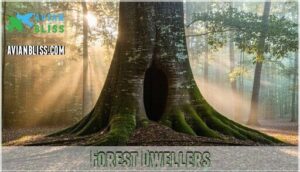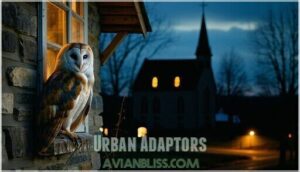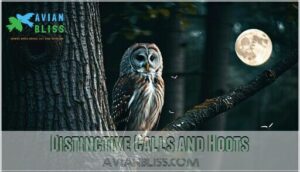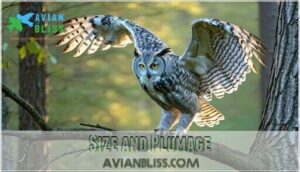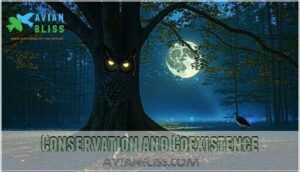This site is supported by our readers. We may earn a commission, at no cost to you, if you purchase through links.
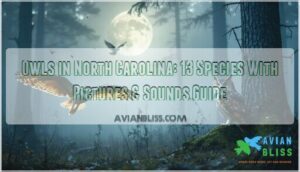 You’ll find thirteen owl species across North Carolina’s diverse landscapes, from coastal plains to mountain peaks.
You’ll find thirteen owl species across North Carolina’s diverse landscapes, from coastal plains to mountain peaks.
The state’s varied ecosystems support everything from tiny Northern Saw-whet Owls that migrate through fall forests to ghostly Barn Owls gliding silently over farmlands. Eastern Screech Owls thrive in both suburban neighborhoods and wild woodlands, while powerful Great Horned Owls claim the largest territories.
Rare Snowy Owls occasionally visit coastal areas during harsh winters. Each species has adapted to specific hunting niches – Barn Owls prefer agricultural fields for rodent hunting, while forest-dwelling species target different prey in dense woodlands.
These nocturnal hunters use specialized adaptations like asymmetrical ear openings and silent flight feathers to locate prey in complete darkness, making them remarkably efficient predators in North Carolina’s night landscape.
Table Of Contents
- Key Takeaways
- North Carolina Owl Species
- Owl Habitats and Nesting
- Identifying North Carolina Owls
- Owl Behavior and Hunting
- Conservation and Coexistence
- Frequently Asked Questions (FAQs)
- Which species of owls may be found in North Carolina?
- What other birds may be confused for owls?
- What does it mean when owls are in your yard?
- What to do if you find an owl in your yard?
- What is the most common owl in North Carolina?
- Is it good or bad to have an owl in your yard?
- Why does an owl sit in my yard?
- What kind of owls hoot at night?
- What time of year do owls lay eggs in NC?
- Are there any albino owls found in North Carolina?
- Conclusion
Key Takeaways
- You’ll find 13 owl species across North Carolina’s diverse habitats, from coastal plains to mountain forests, including common residents like Great Horned Owls and Eastern Screech Owls plus rare winter visitors like Snowy Owls.
- These nocturnal hunters use specialized adaptations like asymmetrical ear openings, silent flight feathers, and heart-shaped facial discs to locate and capture prey with deadly precision in complete darkness.
- You can identify different species by their distinctive calls (Great Horned Owls‘ deep hoots vs. Barn Owls’ screeches), size variations, and unique visual features like ear tufts, eye colors, and plumage patterns.
- All North Carolina owls are legally protected under federal and state wildlife laws, so you’ll need to contact licensed wildlife rehabilitators if you encounter injured birds and practice coexistence strategies for any conflicts.
North Carolina Owl Species
You’ll find thirteen distinct owl species calling North Carolina home, each adapted to specific habitats from dense forests to open grasslands.
These nocturnal hunters display remarkable variations in size, plumage patterns, and behavioral adaptations that make identification both challenging and rewarding for wildlife enthusiasts, particularly due to their nocturnal nature.
Barn Owl Characteristics
Barn Owls showcase remarkable adaptations that make them North Carolina’s most efficient nocturnal hunters.
North Carolina’s silent aerial predators rule the night with deadly precision and unmatched hunting prowess.
Their distinctive heart-shaped facial disc acts like a satellite dish, funneling sounds directly to asymmetrical ear openings for pinpoint prey location accuracy.
The species is protected under federal wildlife laws to conserve their population.
- Facial Disc: Heart-shaped white disc surrounded by brown feathers channels sound waves for precise hunting
- Feather Patterns: Golden-brown upperparts with grayish-white underparts and dark speckles provide camouflage
- Hunting Styles: Silent flight over open fields using acute hearing and low-light vision capabilities
- Territorial Behavior: Monogamous pairs defend nesting sites in barns, abandoned buildings, and tree hollows
Eastern Screech Owl Habitat
Eastern Screech Owl habitat spans diverse Forest Ecology environments throughout North Carolina.
You’ll find these adaptable owls utilizing Tree Cavities in mature hardwoods and pines for Nesting Sites.
They thrive along Woodland Edges where forests meet open areas, and surprisingly, they’ve embraced Urban Landscapes too.
Carolina owl habitat flexibility allows Eastern Screech Owls to nest in residential areas, parks, and suburban neighborhoods, making them North Carolina’s most approachable owl species for backyard wildlife enthusiasts, particularly due to their ability to thrive in various environments, including residential areas.
Great Horned Owl Behavior
Great Horned Owls demonstrate fascinating nocturnal behavior patterns across North Carolina’s diverse landscapes.
You’ll observe their aggressive territorial defense through synchronized hooting calls with mates, establishing dominance over hunting grounds.
Their owl mating rituals involve complex courtship displays, while hunting tactics include silent flight and powerful talons for capturing prey ranging from rabbits to other raptors.
These formidable North Carolina owls exhibit strong social interactions during breeding seasons, maintaining monogamous pairs that defend nesting territories year-round through intimidating vocalizations.
The owls’ nesting habits are characterized by their ability to adapt to various urban nesting environments, which is a notable aspect of their diverse landscapes and behavior.
Northern Saw-whet Owl Migration
North Carolina’s mountain ridges act as migration highways for Northern Saw-whet Owls, those pint-sized nocturnal predators.
You’ll spot their migration patterns peaking from mid-October to early December, as they follow flyway routes south.
Most stop briefly in wooded habitat corridors, using the state as a wintering ground. Banding studies highlight regular owl migration routes and shifting breeding seasons.
Snowy Owl Distribution
After tracking the Northern Saw-whet’s migration, let’s focus on the snowy owl.
Rare sightings in North Carolina mark the southern edge of its geographic range, usually during winter migration.
These north carolina birds breed in the Arctic, but habitat loss and climate impact can push them farther south.
Scan open fields for these striking visitors—owl distribution shifts with food and weather.
The snowy owl’s population is affected by climate change impacts that alter its habitat and prey availability.
Owl Habitats and Nesting
You’ll find North Carolina’s owls occupying three distinct habitat types, each requiring specific nesting strategies to thrive.
From dense forest canopies to open grasslands and suburban neighborhoods, these raptors have adapted their reproductive behaviors to match their chosen environments, utilizing distinct habitat types.
Forest Dwellers
Most owls in north carolina are forest dwellers, requiring tree cavities in dead or hollow trees for nesting habits and daytime roosting.
Forest ecology provides perfect owl camouflage through dense vegetation and mature canopies. Barred owls prefer hardwood floodplains, while Eastern Screech owls favor conifers throughout carolina owl habitat.
These north carolina owl species depend on forest floors for hunting and established forest habitats for successful breeding in woodland environments. Owls often benefit from proper nesting box installations to support their breeding habits, especially in terms of nesting box installations.
Open Field Hunters
While forest-dwelling species prefer dense canopies, several North Carolina owls have mastered Open Terrain hunting.
These Field Dwellers showcase remarkable Hunting Strategies adapted for expansive landscapes. ShortEared Owl and LongEared Owl represent prime examples of this North Carolina wildlife adaptation.
Open field specialists employ these Flight Patterns:
- Low-altitude sweeping flights over grasslands and marshes
- Prey Capture techniques involving feet-first swooping maneuvers
- Owl migration routes following seasonal rodent populations
- Owl habitat selection favoring areas with minimal tree cover
Urban Adaptors
City owls have mastered urban adaptation, transforming parks, cemeteries, and neighborhoods into prime owl habitats in North Carolina.
Eastern Screech Owls readily use nesting boxes you’ll install, while Barn Owls claim church steeples and old buildings.
These urban roosts offer protection from predators and weather, and adaptive hunting techniques help owls catch rats, mice, and insects under streetlights.
Human coexistence thrives when you provide suitable habitat and respect their nocturnal needs.
Identifying North Carolina Owls
You’ll want to focus on three key features when identifying North Carolina’s owls: their distinctive facial patterns, body size, and characteristic vocalizations.
Each species displays unique combinations of ear tufts, eye color, and plumage markings that make field identification straightforward once you know what to look for, utilizing their characteristic vocalizations.
Visual Characteristics
Each species displays unique feather patterns, eye colors, and beak shapes that’ll help you identify them.
Great Horned Owls sport distinctive ear tufts and golden yellow eyes, while Barn Owls have heart-shaped facial disks with dark eyes.
Eastern Screech Owls show mottled plumage textures in gray or red morphs.
Snowy Owls feature white plumage with black speckles, and Barred Owls display horizontal striped patterns across their bodies.
Distinctive Calls and Hoots
Every species produces unique vocal patterns that help with owl call identification in the field.
Barred Owls deliver their famous "Who cooks for you?" hooting sounds, while Great Horned Owls create deep, gravelly territorial calls.
Barn Owls screech rather than hoot, and Eastern Screech-Owls whistle haunting tremolos.
These distinct owl vocalizations and call frequencies make sound mimicry an effective identification tool, and understanding north carolina owl sounds is essential for identifying the various species found in the region, using sound mimicry as a tool for identification.
Size and Plumage
After you’ve tuned your ear to owl calls, shift focus to visual clues.
Owl size and owl wingspan vary wildly—from the tiny Northern Saw-whet to the hefty Great Horned.
Pay attention to feather patterns, plumage types, and owl ear tufts.
Note beak shapes, eye colors, and owl weight, as each species’ unique markings make identification much easier, using visual clues.
Owl Behavior and Hunting
Understanding owl behavior reveals fascinating adaptations that make these raptors exceptional nocturnal hunters.
You’ll discover how different species have evolved specialized techniques for locating, capturing, and consuming their prey in North Carolina’s diverse ecosystems.
Nocturnal Vs. Crepuscular Activity
Most owls are nocturnal hunters, meaning they’re most active during nighttime hours when darkness provides cover for silent stalking.
However, some species exhibit crepuscular behavior, hunting primarily at dawn and dusk when prey is most vulnerable.
Here’s when you’ll spot different owl activity patterns:
- Nocturnal hunters – Great Horned Owls and Eastern Screech Owls dominate night hunting
- Crepuscular species – Short-eared Owls prefer twilight hours for grassland foraging
- Diurnal habits – Snowy Owls hunt during daylight in winter months
- Mixed patterns – Barn Owls adapt their owl nighttime activity based on prey availability
Prey Preferences
North Carolina’s owls demonstrate remarkable dietary flexibility, adapting their hunting strategies to available prey.
Most species prioritize Rodent Prey like mice and voles, which form their primary Small Mammals food source.
Bird Predation varies by species, with Great Horned Owls targeting larger prey while Eastern Screech Owls focus on songbirds.
Summer brings increased Insect Diet consumption, especially beetles and crickets, supplementing their year-round owl diet preferences.
Effective owl hunting requires specialized hunting gear equipment to track and study these birds.
Hunting Techniques
These silent hunters employ specialized techniques that make them apex nocturnal predators.
Their owl hunting strategies combine stealth tactics with remarkable adaptations for capturing prey in darkness.
- Silent Flight – Soft feather edges eliminate wing noise during approach
- Night Vision – Enhanced retinas detect movement in near-total darkness
- Prey Ambush – Motionless perching followed by swift swooping attacks
- Talon Use – Sharp talons deliver crushing grip strength to subdue victims
- Owl Territorial Defense – Strategic positioning within hunting territories maximizes success
To evade predators, owls also utilize effective bird predator avoidance techniques to protect themselves and their nests.
Conservation and Coexistence
You can protect North Carolina’s owl populations by preserving their natural habitats and learning to coexist peacefully with these nocturnal hunters.
When conflicts arise or you encounter injured owls, knowing the proper steps to take guarantees both human safety and owl welfare.
Habitat Protection
Fortunately, all owl species in North Carolina enjoy thorough legal protection under both federal and state wildlife laws.
You can’t legally kill, injure, or harass these magnificent raptors, and destroying active nests carries serious penalties.
Forest Conservation and Wildlife Preservation efforts focus on maintaining suitable owl nesting sites throughout the state.
| Protection Type | Legal Requirements |
|---|---|
| Live Owls | Federal and state permits required for possession |
| Active Nests | Illegal to harm or destroy when eggs/nestlings present |
| Injured Birds | Must contact licensed wildlife rehabilitators |
| Habitat Areas | Protected under Environmental Sustainability guidelines |
| Species Status | All native owls protected by law |
Habitat Restoration and Ecosystem Management programs work to combat habitat loss while supporting north carolina wildlife, utilizing effective bird migration strategies.
These owl conservation initiatives guarantee healthy populations for future generations.
Dealing With Conflicts
After focusing on owl habitat preservation, you might wonder how to handle close encounters.
If you experience owl attacks or property issues, prioritize human safety and use owl deterrents like motion-activated lights.
Avoid direct confrontation—coexistence strategies work best.
Secure pets at night, manage outdoor lighting, and maintain respectful distances to support owl conservation while practicing effective owl conflict resolution and owl protection.
Reporting Injured or Orphaned Owls
When conflicts arise, sometimes you’ll stumble upon an injured owl or orphaned chicks. Quick action protects both the bird and the broader owl habitat preservation effort.
Here’s what you can do for Owl Rescue:
- Call a licensed wildlife rehabilitator
- Avoid handling the owl yourself
- Check the north carolina owl species list for ID
- Support local Wildlife Rehabilitation programs
Effective owl rescue often requires specialized Owl Rescue Kits to handle and care for the birds safely.
Frequently Asked Questions (FAQs)
Which species of owls may be found in North Carolina?
You’ll find eight owl species in North Carolina: Barn Owl, Eastern Screech Owl, Great Horned Owl, Northern Saw-whet Owl, Short-eared Owl, Long-eared Owl, Barred Owl, and occasionally Snowy Owl during winter months.
What other birds may be confused for owls?
You’ll often mistake hawks, falcons, and nighthawks for owls due to their similar silhouettes and nocturnal behavior.
Hawks have longer necks and narrower wings, while falcons show pointed wings and faster flight patterns than owls’ silent gliding.
What does it mean when owls are in your yard?
Owls in your yard typically indicate abundant prey like rodents, suitable nesting sites, or nearby hunting territories. They’re attracted to food sources and safe roosting spots, not supernatural meanings.
What to do if you find an owl in your yard?
Surprisingly, discovering an owl resting in your backyard isn’t cause for alarm.
Observe quietly from a distance, ensuring pets stay indoors. Don’t approach or attempt capture.
Most owls will naturally relocate by dawn. If injured, contact local wildlife rehabilitation centers immediately.
What is the most common owl in North Carolina?
The Great Horned Owl stands as North Carolina’s most common owl species. You’ll spot these magnificent birds throughout the state, recognizing them by their distinctive ear tufts and golden eyes.
Is it good or bad to have an owl in your yard?
If you spot an owl in your yard, consider it a feathered blessing.
You’re gaining a natural pest controller, as these raptors hunt rodents and insects.
Just keep pets indoors at night, and enjoy nature’s watchful guardian.
Why does an owl sit in my yard?
Like a silent sentinel, you’ll find an owl perched in your yard when it’s hunting prey, seeking shelter, or defending territory.
Your yard’s food sources, cover, and low disturbance make it an attractive stopover.
What kind of owls hoot at night?
Most owls you’ll hear hooting at night are Great Horned Owls with their deep territorial calls, Barred Owls with distinctive hoots, and Eastern Screech-Owls making trilling sounds.
What time of year do owls lay eggs in NC?
You’ll find most species laying eggs in late winter to early spring, usually February through April.
If you’re out at dusk, listen for territorial hoots—those signals mean nesting is underway, and eggs aren’t far behind.
Are there any albino owls found in North Carolina?
You won’t often see albino owls in North Carolina.
True albinism in owls is extremely rare due to genetic odds and survival challenges.
If you glimpse a pale owl, it’s likely leucistic, not fully albino.
Conclusion
Like sentinels of the night, owls in North Carolina stand as nature’s most efficient hunters across thirteen distinct species.
You’ll discover these remarkable predators from the Outer Banks’ salt marshes to the Blue Ridge’s ancient forests.
Whether you’re tracking a Great Horned Owl’s territorial hoots or catching glimpses of a rare Snowy Owl during winter migration, understanding their behaviors enhances your wildlife experiences.
By protecting their habitats and respecting their nocturnal activities, you’re helping preserve North Carolina’s rich avian diversity for future generations to appreciate and study.

